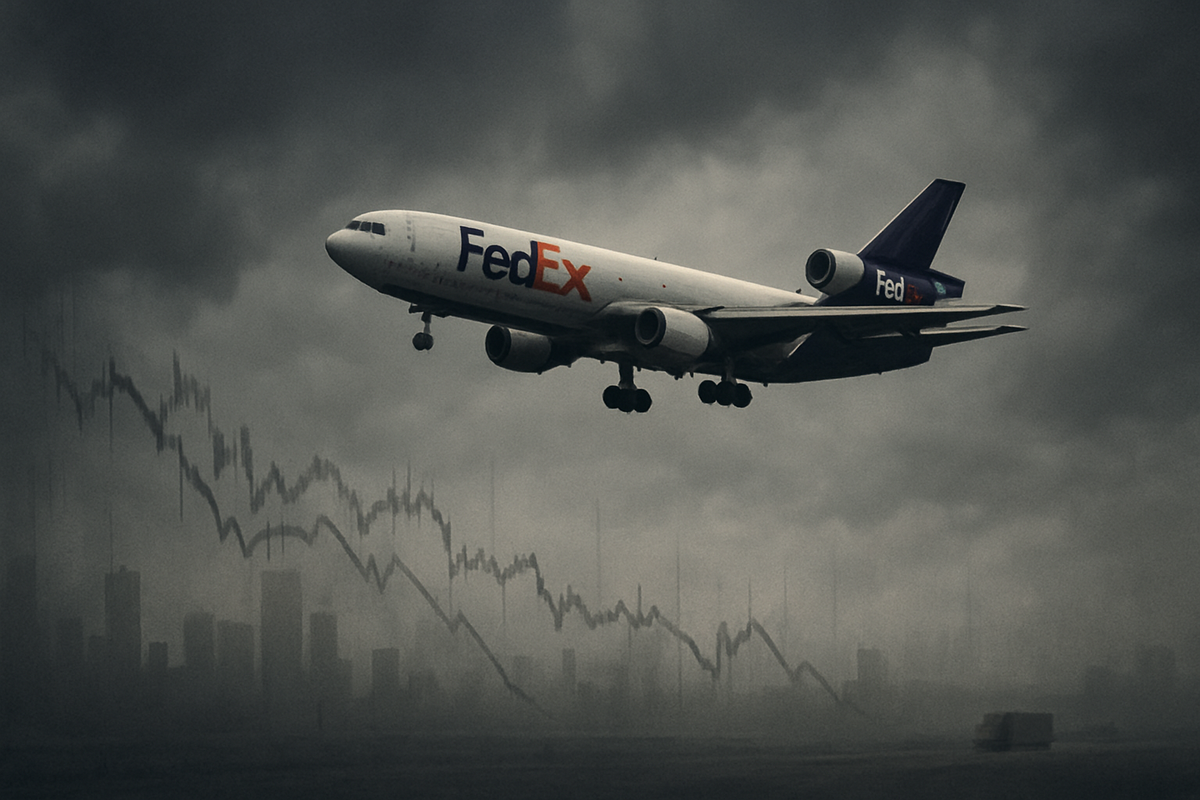
Memphis, TN – November 11, 2025 – Global logistics giant FedEx Corporation (NYSE: FDX) finds itself at a critical juncture, with market analysts and industry observers flagging significant headwinds that could drive its stock performance into negative territory. Despite recent optimistic guidance for its fiscal Q2 2026, which spurred a temporary "relief rally," the company continues to navigate a complex landscape marked by a persistent slowdown in global shipping demand, escalating operational costs, and intensifying competition. This precarious position suggests that FedEx could be a prominent bottom mover in the market, as investors weigh short-term gains against more profound, systemic challenges.
The immediate implications of these pressures are already palpable, with the broader air freight and cargo industry experiencing a "negative earnings outlook" and underperforming the S&P 500. For FedEx, this translates into potential erosion of market share, diminished profitability, and increased scrutiny from investors concerned about its long-term growth trajectory. The convergence of a challenging macroeconomic climate with specific operational disruptions, such as the recent grounding of MD-11 cargo planes, creates a volatile environment that could see FedEx’s stock experience significant downward pressure in the coming months, particularly as the crucial holiday shipping season unfolds.
Deep Dive into FedEx's Turbulent Skies
FedEx's current challenges are multifaceted, stemming from a confluence of macroeconomic shifts, operational hurdles, and a fiercely competitive market. The most pressing issue is the sustained downturn in global shipping demand, particularly evident in Asia and Europe, leading to weaker package volumes and below-par freight rates. The Cass Freight Shipments Index, a key indicator for the industry, has shown a year-over-year decline for seven consecutive months leading up to September 2025, signaling a prolonged slump. This softness is especially pronounced in Business-to-Business (B2B) volumes, a critical segment for FedEx Freight, and has driven a shift towards lower-margin deferred service options, as evidenced by a 5% rise in U.S. deferred volume against a 3% decrease in priority shipping in Q3 FY2025.
Compounding the demand-side issues are significant operational headwinds. Fluctuating fuel prices remain a constant burden for FedEx's vast air and ground fleet. The company also faces higher wage and purchased transportation rates, which partially offset gains in its Express segment during Q1 FY2026. A notable financial impact for Q1 FY2026 was the $120 million headwind from the expiration of the U.S. Postal Service (USPS) contract and an additional $170 million from global trade policies. More recently, operational disruptions have emerged following a UPS cargo plane crash and the subsequent, recommended grounding of MD-11 aircraft by both FedEx and UPS. This grounding could lead to significant delays and capacity strains, particularly as the holiday season approaches, further escalating expenses and potentially impacting service reliability. Historically, FedEx Freight's underinvestment in IT has also limited its ability to compete in increasingly digitally-driven logistics markets.
The timeline of these events paints a picture of growing pressure. Earlier in 2025, FedEx had already cut its fiscal year forecast, citing tepid industrial demand and predicting flat to slightly down revenue. Analyst sentiment has mirrored this trend, with downward revisions to earnings per share expectations extending to Q2 FY2027. While the company did beat Q1 FY2026 earnings estimates, analysts quickly pointed to an "uncertain demand environment and inflationary pressures dampen outlook." Key stakeholders, including shareholders, employees, and customers, are all closely watching how FedEx navigates these challenges. The company's management is focused on its "DRIVE" cost-cutting initiatives, but the efficacy of these measures against such broad industry headwinds remains a key concern. Initial market reactions to negative news or analyst downgrades have often seen the stock dip, only to recover slightly on short-term positive news, suggesting a volatile trading pattern driven by conflicting signals.
Industry Ripples: Winners and Losers in a Shifting Landscape
The potential negative performance of FedEx (NYSE: FDX) sends ripple effects across the entire logistics and transportation sector, creating both challenges and opportunities for competitors and partners. In a market where FedEx struggles with declining volumes and operational costs, rival carriers like United Parcel Service (NYSE: UPS) and DHL (FWB: DHL) are positioned to either capitalize on FedEx's vulnerabilities or face similar industry-wide pressures. If FedEx's service reliability or capacity is compromised due to issues like the MD-11 grounding, customers might shift their business to UPS or DHL, offering these competitors a chance to gain market share. However, it's crucial to note that many of the macroeconomic headwinds, such as reduced global shipping demand and higher fuel costs, affect all major players in the industry, meaning that even competitors might experience a dampened growth environment.
Within the Less-Than-Truckload (LTL) market, where FedEx Freight operates, the competition is particularly fierce. Strong contenders like Old Dominion Freight Line (NASDAQ: ODFL), XPO Logistics (NYSE: XPO), and Saia (NASDAQ: SAIA) stand to benefit if FedEx Freight's underinvestment in IT or operational challenges lead to service degradation or increased pricing. These more agile or technologically advanced LTL carriers could attract customers seeking more efficient and digitally integrated shipping solutions. Conversely, any significant downturn in overall freight volumes due to the broader industrial slowdown would negatively impact all LTL players, including these competitors.
Beyond direct competitors, the struggles of a major logistics provider like FedEx can also impact its partners and suppliers. Companies that provide aircraft maintenance, ground transportation services, or fuel to FedEx could see a reduction in demand or renegotiation of contracts if FedEx implements further cost-cutting measures or scales back operations. E-commerce businesses and retailers, who rely heavily on FedEx for last-mile delivery, might face increased shipping costs or potential delays, especially during peak seasons. This could prompt them to diversify their shipping partners or invest further in their own logistics capabilities, as seen with Amazon.com (NASDAQ: AMZN) and its rapidly expanding in-house delivery network. Amazon’s growing logistics arm, in particular, represents a significant long-term competitive threat, potentially siphoning off package volume that FedEx once handled.
Broader Implications: A Bellwether for Global Trade
FedEx's current struggles are not isolated; they are a potent reflection of broader industry trends and the global economic climate. The sustained decline in global shipping demand, particularly in air freight, serves as a bellwether for international trade health. When major logistics players like FedEx report reduced volumes and a shift towards lower-margin deferred services, it signals a slowdown in manufacturing, consumer spending, and cross-border commerce. This trend is consistent with ongoing geopolitical uncertainties and high inflation rates that continue to dampen consumer sentiment and growth expectations worldwide. The industry's underperformance relative to the S&P 500 underscores a period of significant contraction and re-evaluation for global supply chains.
The operational challenges faced by FedEx, such as fluctuating fuel prices, wage inflation, and the recent MD-11 grounding, highlight the inherent vulnerabilities within the capital-intensive logistics sector. These issues are not unique to FedEx; they represent systemic pressures that can affect any company with a vast global infrastructure and reliance on specific transportation assets. The grounding of aircraft, even if temporary, exposes the fragility of just-in-time supply chains and the potential for disruptions to cascade rapidly, especially during critical periods like the holiday season. Regulatory and policy implications also play a role; the expiration of the USPS contract and global trade policies imposing headwinds underscore how governmental decisions can directly impact the profitability and strategic direction of logistics giants.
Historically, the logistics industry has always been cyclical, closely mirroring global economic cycles. Periods of economic contraction or uncertainty often lead to reduced freight volumes and increased cost pressures, similar to the dot-com bust or the 2008 financial crisis. However, the current environment is unique due to the combined impact of lingering pandemic-era supply chain shifts, persistent inflation, and geopolitical fragmentation. The rise of "nearshoring" or "reshoring" manufacturing, driven by desires for supply chain resilience, could fundamentally alter long-haul freight patterns, potentially impacting the traditional business models of integrated carriers like FedEx. Furthermore, the increasing focus on environmental sustainability and emissions reductions could lead to new regulatory burdens and investment requirements for fleet modernization, adding another layer of complexity and cost for companies in this sector.
Navigating the Road Ahead: Strategic Pivots and Market Shifts
The path forward for FedEx (NYSE: FDX) in this challenging environment will require strategic agility and a keen understanding of evolving market dynamics. In the short term, the company's immediate focus will likely remain on its "DRIVE" cost-cutting initiatives, aiming to streamline operations and improve efficiency to offset declining revenues and rising expenses. Successfully navigating the critical holiday shipping season, especially with potential capacity constraints from grounded aircraft, will be paramount. Any further operational missteps or significant service disruptions during this period could severely impact customer loyalty and financial performance, leading to further negative market sentiment. Investors should closely watch Q2 FY2026 earnings reports for signs of effective cost management and any updates on demand trends.
Looking further ahead, the long-term possibilities for FedEx hinge on its ability to adapt to a permanently altered logistics landscape. This includes addressing the structural shift towards lower-margin deferred services and the increasing demand for e-commerce logistics, where competitors like Amazon.com (NASDAQ: AMZN) are making significant inroads. Potential strategic pivots could involve further investments in automation and technology to improve efficiency and reduce labor costs, particularly in its ground operations. Enhancing its digital capabilities, an area where FedEx Freight has historically lagged, will be crucial for competitive positioning in a digitally-driven market. The company might also explore strategic partnerships or acquisitions to bolster its capabilities in specific regions or service offerings, or even consider divestitures of underperforming segments.
Market opportunities may emerge from the very challenges it faces. As smaller logistics providers struggle, FedEx, with its vast network, could potentially acquire distressed assets or gain market share through strategic pricing. The growing complexity of global supply chains could also create demand for specialized, high-value logistics services that FedEx is uniquely positioned to offer. However, significant challenges loom, including the continued threat of a global recession, persistent inflationary pressures, and the ongoing competitive intensity from both traditional rivals and new entrants. Potential scenarios range from a gradual recovery as global trade stabilizes and cost-cutting measures take hold, to a more prolonged period of underperformance if macroeconomic headwinds persist and strategic adaptations prove insufficient. Investors should monitor global economic indicators, commodity prices (especially fuel), and competitor performance to gauge FedEx's trajectory.
Conclusion: A Crossroads for the Logistics Giant
FedEx (NYSE: FDX) stands at a pivotal moment, navigating a confluence of macroeconomic pressures, operational challenges, and intense competition that collectively paint a picture of potential negative performance in the coming months. The core takeaways from this analysis are clear: a sustained slowdown in global shipping demand, particularly in B2B and priority services, is eroding revenue, while rising operational costs—from fuel and wages to the impacts of contract expirations and aircraft groundings—are squeezing margins. Despite some short-term positive guidance, the broader industry outlook remains cautious, and analysts have consistently revised down earnings expectations for the logistics giant.
Moving forward, the market will be closely assessing FedEx's ability to execute its "DRIVE" cost-cutting initiatives and adapt to a fundamentally shifting logistics landscape. The successful management of the critical holiday shipping season, coupled with strategic investments in technology and automation, will be crucial for shoring up investor confidence. The company's long-term success hinges on its capacity to innovate and differentiate its services in an environment where customer expectations are rising and competition from both traditional rivals and e-commerce giants is intensifying. The potential for further stock underperformance remains a tangible risk if these underlying challenges are not effectively addressed.
Investors should maintain a vigilant watch on global economic indicators, particularly those related to manufacturing and trade, as well as commodity prices like oil. Monitoring competitor performance, especially that of UPS (NYSE: UPS) and key LTL players, will offer insights into broader industry health and competitive dynamics. Furthermore, any significant developments in global trade policies or regulatory changes could materially impact FedEx's operational environment. While FedEx has a history of resilience, the current confluence of factors suggests a period of significant transformation and potential volatility, making it a stock to watch closely for both risks and any emerging opportunities in the evolving logistics sector.
This content is intended for informational purposes only and is not financial advice





